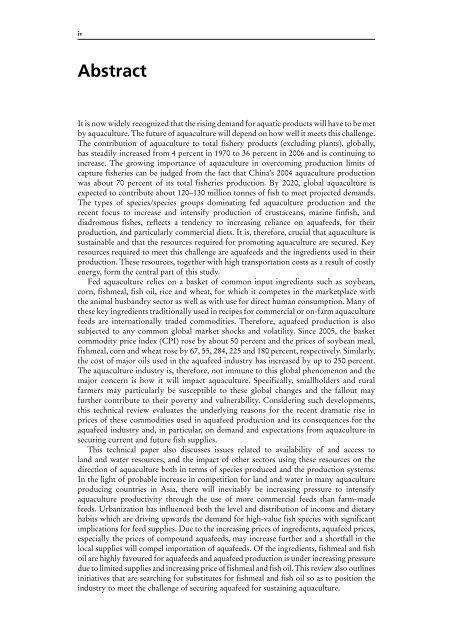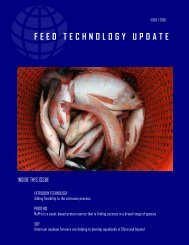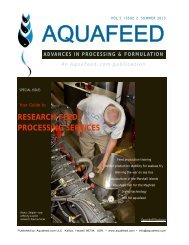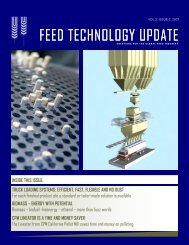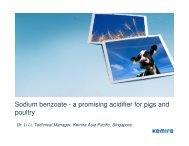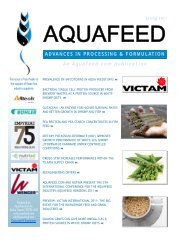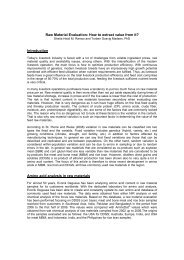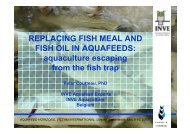Read Document - AquaFeed.com
Read Document - AquaFeed.com
Read Document - AquaFeed.com
Create successful ePaper yourself
Turn your PDF publications into a flip-book with our unique Google optimized e-Paper software.
ivAbstractIt is now widely recognized that the rising demand for aquatic products will have to be metby aquaculture. The future of aquaculture will depend on how well it meets this challenge.The contribution of aquaculture to total fishery products (excluding plants), globally,has steadily increased from 4 percent in 1970 to 36 percent in 2006 and is continuing toincrease. The growing importance of aquaculture in over<strong>com</strong>ing production limits ofcapture fisheries can be judged from the fact that China’s 2004 aquaculture productionwas about 70 percent of its total fisheries production. By 2020, global aquaculture isexpected to contribute about 120–130 million tonnes of fish to meet projected demands.The types of species/species groups dominating fed aquaculture production and therecent focus to increase and intensify production of crustaceans, marine finfish, anddiadromous fishes, reflects a tendency to increasing reliance on aquafeeds, for theirproduction, and particularly <strong>com</strong>mercial diets. It is, therefore, crucial that aquaculture issustainable and that the resources required for promoting aquaculture are secured. Keyresources required to meet this challenge are aquafeeds and the ingredients used in theirproduction. These resources, together with high transportation costs as a result of costlyenergy, form the central part of this study.Fed aquaculture relies on a basket of <strong>com</strong>mon input ingredients such as soybean,corn, fishmeal, fish oil, rice and wheat, for which it <strong>com</strong>petes in the marketplace withthe animal husbandry sector as well as with use for direct human consumption. Many ofthese key ingredients traditionally used in recipes for <strong>com</strong>mercial or on-farm aquaculturefeeds are internationally traded <strong>com</strong>modities. Therefore, aquafeed production is alsosubjected to any <strong>com</strong>mon global market shocks and volatility. Since 2005, the basket<strong>com</strong>modity price index (CPI) rose by about 50 percent and the prices of soybean meal,fishmeal, corn and wheat rose by 67, 55, 284, 225 and 180 percent, respectively. Similarly,the cost of major oils used in the aquafeed industry has increased by up to 250 percent.The aquaculture industry is, therefore, not immune to this global phenomenon and themajor concern is how it will impact aquaculture. Specifically, smallholders and ruralfarmers may particularly be susceptible to these global changes and the fallout mayfurther contribute to their poverty and vulnerability. Considering such developments,this technical review evaluates the underlying reasons for the recent dramatic rise inprices of these <strong>com</strong>modities used in aquafeed production and its consequences for theaquafeed industry and, in particular, on demand and expectations from aquaculture insecuring current and future fish supplies.This technical paper also discusses issues related to availability of and access toland and water resources, and the impact of other sectors using these resources on thedirection of aquaculture both in terms of species produced and the production systems.In the light of probable increase in <strong>com</strong>petition for land and water in many aquacultureproducing countries in Asia, there will inevitably be increasing pressure to intensifyaquaculture productivity through the use of more <strong>com</strong>mercial feeds than farm-madefeeds. Urbanization has influenced both the level and distribution of in<strong>com</strong>e and dietaryhabits which are driving upwards the demand for high-value fish species with significantimplications for feed supplies. Due to the increasing prices of ingredients, aquafeed prices,especially the prices of <strong>com</strong>pound aquafeeds, may increase further and a shortfall in thelocal supplies will <strong>com</strong>pel importation of aquafeeds. Of the ingredients, fishmeal and fishoil are highly favoured for aquafeeds and aquafeed production is under increasing pressuredue to limited supplies and increasing price of fishmeal and fish oil. This review also outlinesinitiatives that are searching for substitutes for fishmeal and fish oil so as to position theindustry to meet the challenge of securing aquafeed for sustaining aquaculture.


